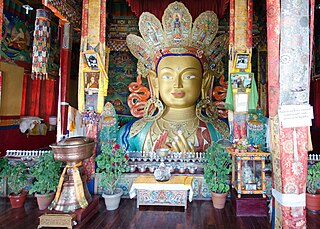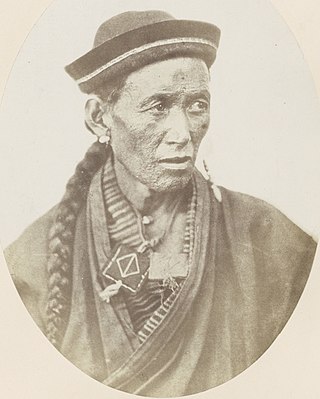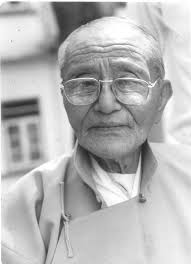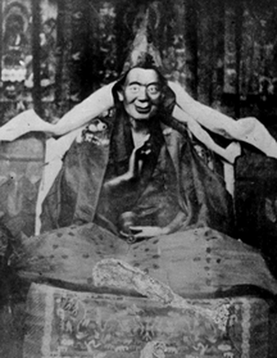
Tseten Dorjee, (born 2 December 1960, Darjeeling, India) is a Tibetan thangka Artist.

Tseten Dorjee, (born 2 December 1960, Darjeeling, India) is a Tibetan thangka Artist.
Tseten Dorjee was born 2 December 1960 in Darjeeling and lived in India [1] to receive his early education at the Central School for Tibetans, in Darjeeling, India. Dorjee started the study of thangka painting between 1974 and 1980 when he took private lessons from the late Venerable Ngawang Norbu (1903–1996). He continued his study from 1980 to 1986 at the Gyudmed Tantric Monastery, located in Mysore, South India.
Dorjee received commissions from the 14th Dalai Lama, the Royal Family of Sikkim and various major monasteries in India. Dorjee traveled and painted thangkas outside of India in Bhutan, Nepal, Munich and USA. [2]
In accordance with the wish of his teacher, Dorjee started teaching thangka painting in 1995. Over the years, 11 students, after four to five years under his guidance became accomplished thankga painters. As of 2011 he was instructing six full-time students. Dorjee became a faculty member of Naropa University's Study Abroad Program in Sikkim in the fall of 2002. Its Director, Clarke D. Warren, stated, "Being a scholar of Tibetan Buddhism I have been an avid connoisseur of thangka painting for many years and Tseten is amongst the finest I have seen anywhere, in its mastery of tradition, style and execution."[ This quote needs a citation ]
Dorjee founded and serves as director of a non-profit organization that provides medical care, education and clothing and living costs for poor families, needy elders and children.[ citation needed ]

Kalimpong is a town and the headquarters of an eponymous district in the Indian state of West Bengal. It is located at an average elevation of 1,250 metres (4,101 ft). The town is the headquarters of the Kalimpong district. The region comes under Gorkhaland Territorial Administration which is an autonomous governing body within the state of West Bengal. The Indian Army's 27 Mountain Division is located on the outskirts of the city.

The vast majority of surviving Tibetan art created before the mid-20th century is religious, with the main forms being thangka, paintings on cloth, mostly in a technique described as gouache or distemper, Tibetan Buddhist wall paintings, and small statues in bronze, or large ones in clay, stucco or wood. They were commissioned by religious establishments or by pious individuals for use within the practice of Tibetan Buddhism and were manufactured in large workshops by monks and lay artists, who are mostly unknown. Various types of religious objects, such as the phurba or ritual dagger, are finely made and lavishly decorated. Secular objects, in particular jewellery and textiles, were also made, with Chinese influences strong in the latter.

A thangka is a Tibetan Buddhist painting on cotton, silk appliqué, usually depicting a Buddhist deity, scene, or mandala. Thangkas are traditionally kept unframed and rolled up when not on display, mounted on a textile backing somewhat in the style of Chinese scroll paintings, with a further silk cover on the front. So treated, thangkas can last a long time, but because of their delicate nature, they have to be kept in dry places where moisture will not affect the quality of the silk. Most thangkas are relatively small, comparable in size to a Western half-length portrait, but some are extremely large, several metres in each dimension; these were designed to be displayed, typically for very brief periods on a monastery wall, as part of religious festivals. Most thangkas were intended for personal meditation or instruction of monastic students. They often have elaborate compositions including many very small figures. A central deity is often surrounded by other identified figures in a symmetrical composition. Narrative scenes are less common, but do appear.

The Bhutias or Drejongpas are a Tibetan ethnic group native to the Indian state of Sikkim who speak Drejongke, a Tibetic language which descends from old Tibetan. In addition to the majority of them living in the state of Sikkim, significant numbers of them also reside in the Darjeeling and Kalimpong districts of northern West Bengal as well as in countries such as Nepal and Bhutan.

The history of Sikkim begins with the indigenous Lepcha's contact with early Tibetan settlers. Historically, Sikkim was a sovereign Monarchical State in the eastern Himalayas. Later a protectorate of India followed by a merger with India and official recognition as a state of India. Lepchas were the main inhabitants as well as the Rulers of the land up to 1641. Lepchas are generally considered to be the first people, Indigenous to Sikkim also includes Darjeeling.

Dzongsar Khyentse Chökyi Lodrö was a Tibetan lama, a master of many lineages, and a teacher of many of the major figures in 20th-century Tibetan Buddhism. Though he died in 1959 in Sikkim, and is not so well known in the West; he was a major proponent of the Rimé movement within Tibetan Buddhism, and had a profound influence on many of the Tibetan lamas teaching today.

Mindrolling Monastery, is one of the "Six Mother Monasteries" of the Nyingma school in Tibet. It was founded by Rigzin Terdak Lingpa in 1676. Tendrak Lingpa's lineage is known as the Nyo lineage. The name in Tibetan means "Place of Perfect Emancipation". It is located in Zhanang County, Shannan Prefecture, Tibet Autonomous Region, China, known as U-Tsang. Mindrolling Monastery is approximately 43 kilometers east of the Lhasa airport, on the south side of the Tsangpo river.

Chatral Sangye Dorje Rinpoche was a Tibetan Dzogchen master and a reclusive ngagpa yogi, known for his great realization and strict discipline. Chatral Sangye Dorje was a disciple of Khenpo Ngawang Pelzang and was widely regarded as one of the most highly realized Dzogchen yogis. In addition to his relationship with Khenpo Ngagchung, Chatral Sangye Dorje also studied with some of the last century's most renowned masters, including Dudjom Jigdral Yeshe Dorje, Dzongsar Khyentse Chökyi Lodrö, and the famed Kunzang Dekyong Wangmo. Chatral Sangye Dorje was one of the primary lineage holders of the Longchen Nyingthig, and in particular the lineage that descends through Jigme Lingpa's heart son Jigme Gyalwe Nyugu and then on to Patrul Rinpoche.

Sherab Palden Beru was an exiled Tibetan thangka artist who played a key role in preserving the art-form through the training of western students over a period of more than four decades.

Kazi Lhendup Dorjee, also spelled Lhendup Dorji or Lhendup Dorji Khangsarpa was an Indian politician who was the first chief minister of Sikkim from 1975 to 1979 after its union with India. He was the first Prime Minister of Sikkim from 1974 to 1975. He also served as the Executive Council of Sikkim from 1967 to 1970. He was a member of INC after 1975 and Sikkim National Congress before 1975.
The Khamtrul tulku lineage is part of the Dongyud Palden section of the Drukpa Lineage of the Kagyu school of Tibetan Buddhism.

The Kingdom of Sikkim, officially Dremoshong until the 1800s, was a hereditary monarchy in the Eastern Himalayas which existed from 1642 to 16 May 1975, when it was annexed by India. It was ruled by Chogyals of the Namgyal dynasty.

George Nicolas de Roerich was a prominent 20th-century Tibetologist. His name at birth was YuriNikolaevich Rerikh. George's work encompassed many areas of Tibetan studies, but in particular he is known for his contributions to Tibetan dialectology, his monumental translation of the Blue Annals, and his 11-volume Tibetan-Russian-English dictionary.

The Pemayangtse Monastery is a Buddhist monastery in Pemayangtse, near Gyalshing city in Gyalshing district in the northeastern Indian state of Sikkim, located 6 km from Gyalshing city, the district headquarters, 110 km west of Gangtok. Planned, designed and founded by Lama Lhatsun Chempo in 1647, it is one of the oldest and premier monasteries of Sikkim, also the most famous in Sikkim. Originally started as a small Lhakhang, it was subsequently enlarged during the reign of the third Chogyal Chakdor Namgyal and Khenchen Rolpai Dorjee in the year 1705 and consecrated by the third Lhatsun Chenpo Dzogchen Jigme Pawo in the year 1710 C.E. The monastery follows the Nyingma Order of Tibetan Buddhism and controls all other monasteries of that Order in Sikkim. The monks of this monastery are normally chosen from the Bhutias of Sikkim.
Amdo Jampa, also known as Jampa Tseten, was a Tibetan painter.

Dr. Sarika Singh is perhaps the first Indian female master painter and teacher in the Buddhist tradition of Thangka Painting. Born on 13 August 1976, in New Delhi, she began her studies in the art of Thangka painting, in 1996, at the prestigious Norbulingka Institute in Dharamshala, Northern India under the tutelage of her master, Tempa Choephel. In the year 2015, she completed her Master’s degree in ‘Buddhist and Tibetan Studies’ from Punjab University, and ‘PhD’ from Central University of Himachal Pradesh in the year 2021.
Gankhüügiin Pürevbat was a Mongolian painter, art collector, museum director and Buddhist teacher in the Vajrayana School. Lam Pürevbat was the founder of the Zanabazar Mongolian Institute of Buddhist Art. He was born in 1965 in Bornuur in the Töv Province.

Ging Gompa Tib:གསང་ཆེན་མཐོང་གྲོལ་གླིང is a Buddhist monastery in Darjeeling, West Bengal, India. The monastery is located in Ging, about 10 km (6.2 mi) from Darjeeling. It is one of the oldest monasteries in Darjeeling and subscribes to the Nyingmapa tradition of Tibetan Buddhism. On historical grounds, the monastery is still under the administrative control of the Government of Sikkim.

Domo Geshe Rinpoche is said to have been Shariputra, the Mahadsiddha Gayadhara, Dharmashri, Munijnana, Tönmi Sambhota, King Trisong Detsen, Dromtönpa, Milarepa, Khedrup Rinpoche, and Dragpa Gyaltsen in previous lives.
Khandu Wangchuk Bhutia is an India thangka painter from the Sikkim, known for his exquisite creative works in the Thangka style of painting. Thangka is a Tibetan Buddhist painting on cotton, silk appliqué, usually depicting a Buddhist deity, scene, or mandala. Thangkas are traditionally kept unframed and rolled up when not on display, mounted on a textile backing somewhat in the style of Chinese scroll paintings, with a further silk cover on the front. Khandu Wangchuk Bhutia hails from Sakyong in West Sikkim and had his formal education from Government Senior Secondary School in Pelling and at Senior Secondary School at Namchi. After his formal education, he was ordained into monastic life at the Pemayangtse Monastery. In the monastery, he took up Thangka painting as a profession. He trained in Thangka painting under several renowned thangka painters like Dungzin Rimpoche, late Jigme Wangchuk Lama, late Phuntsok Sangpo and late Zapa Acho.